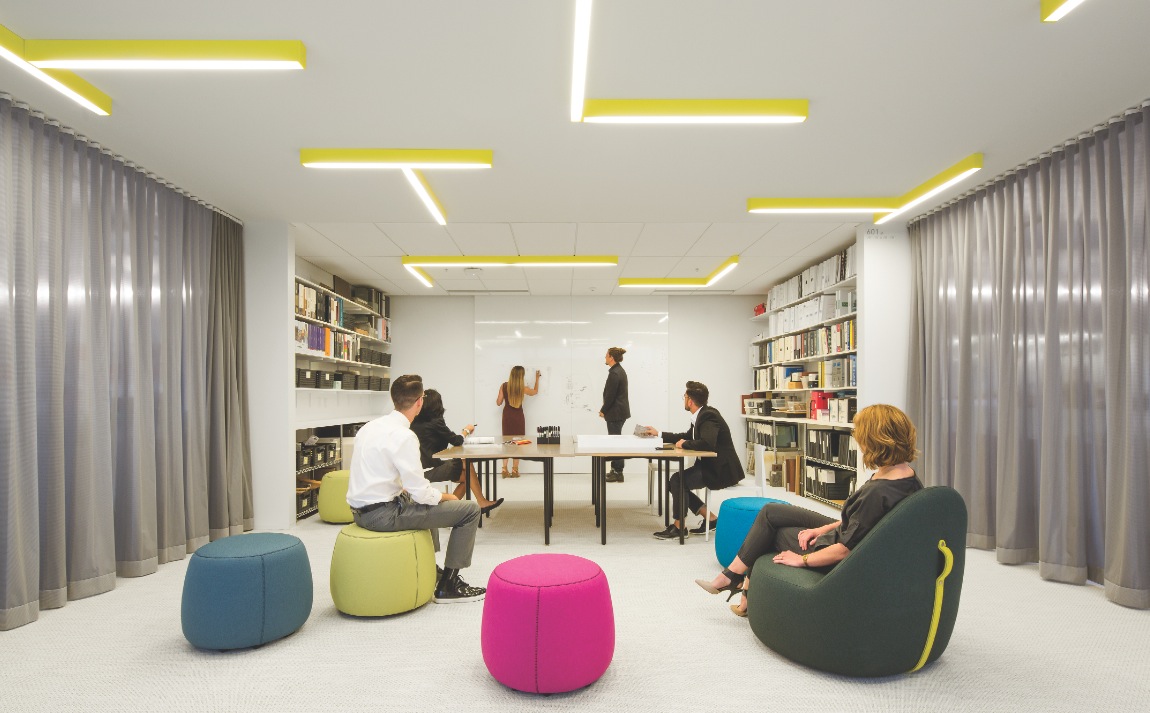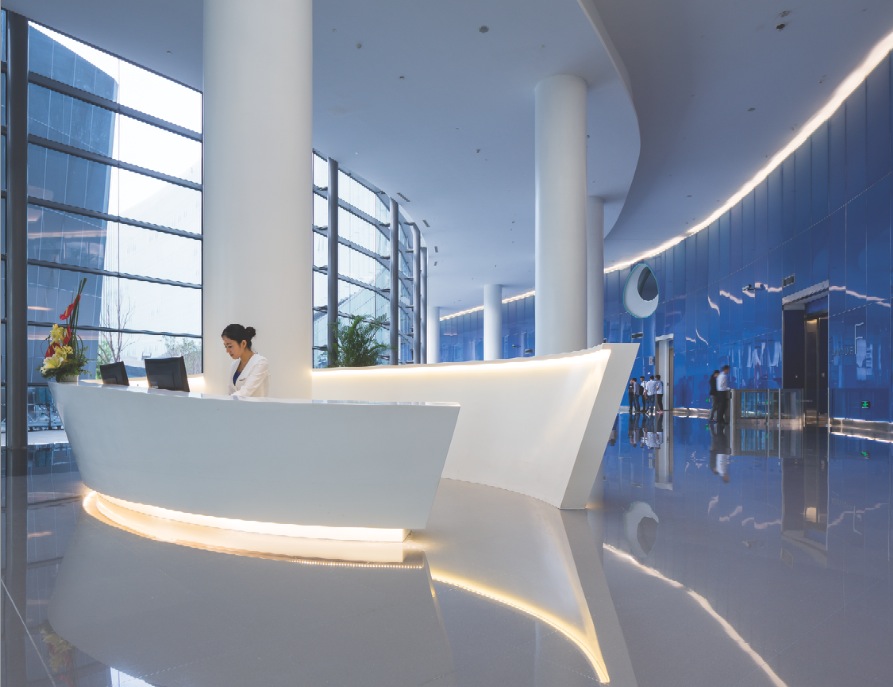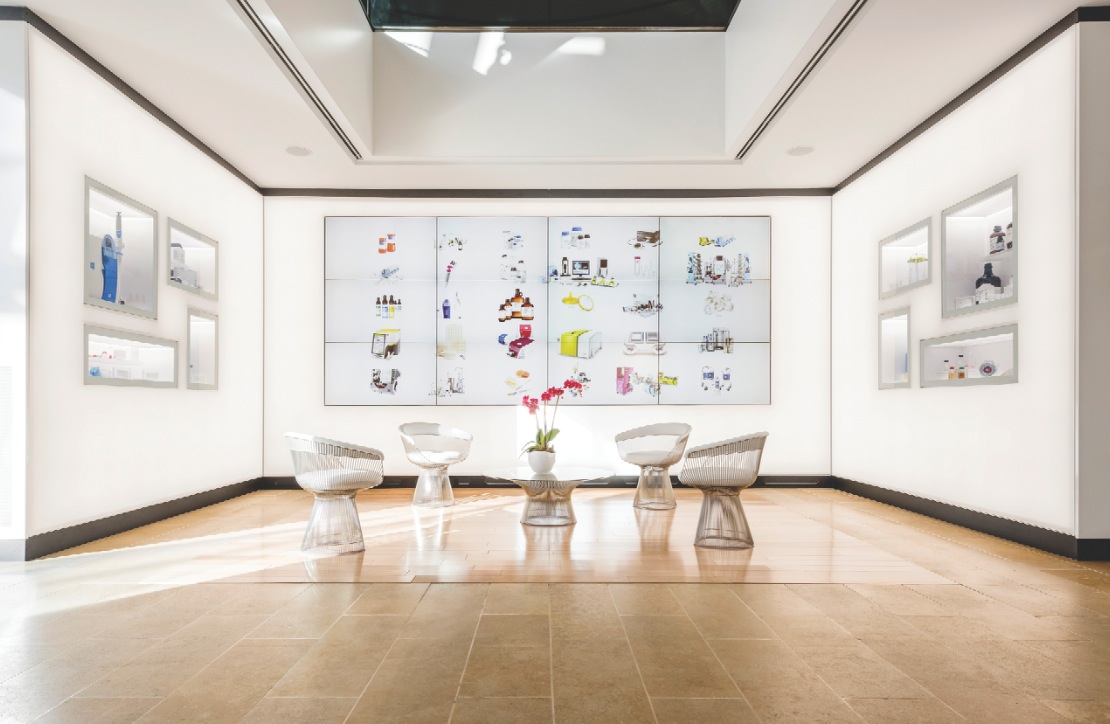Last August, the town of Irondequoit, N.Y., near Rochester, opened its $13 million, 37,800-sf public library. The entry lobby is illuminated by organic light-emitting diode (OLED) fixtures, one of the few examples to date of this lighting technology being used in nonresidential building.
OLEDs are among a handful of solid-state lighting alternatives that AEC firms are evaluating as complements to light-emitting diode (LED) products that have practically become standard for many of their projects.
Forbes recently projected that LEDs would capture 70% of the global lighting market by 2020, up from 31% in 2015. LEDInside.com estimates the value of LEDs’ market share last year at $25.7 billion.
Arup’s office in Boston has made “the complete transition” to LEDs, and is currently working on two large lab projects in which “we’re leveraging this technology to push the energy message,” says Jake Wayne, the firm’s Senior Lighting Designer.
“LEDs proved that this industry could change,” says Sara Schonour, LC, Associate IALD, Associate VP and Lighting Designer with CannonDesign, and a BD+C 40 Under 40 honoree (Class of 2013). “And the lighting industry is now asking, ‘What’s next?’”
Lighting experts pose this question because, while LEDs are becoming increasingly prevalent in design and construction, the technology has its shortcomings.
On the plus side, LEDs “allow fine-tuning of color to an incredible degree,” says Stephen Blackman, a 30-year lighting industry veteran and President and Chief Design Officer for Blackjack Lighting, which designs high-end decorative LED fixtures. He notes, too, that LED technology is embracing wireless controls, which are a major area of concentration for manufacturers.
However, Blackman and AEC experts lament the absence of standardization for LEDs. “There’s a lot of junk out there,” says Schonour. “Most suppliers have specific niches, and just because somebody’s down lights are fabulous doesn’t mean their lineals are great.”
Randy Fisher, IALD, MIES, LC, Senior Lighting Designer with NBBJ, notes that LED components typically come from multiple sources, “so it’s harder to know one LED from another,” or to gauge quality based on branding.
Blackman says dimming continues to be difficult with LEDs, “because the people who make dimmers and drivers don’t talk to each other.” Arup’s Wayne believes LEDs still need to catch up with other lighting technologies in such areas as tight-beam optics and optical control.
LEDs, in most experts’ estimation, still have room for improvement. That may explain why this technology has yet to be challenged competitively by other solid-state products that are either pricier, less efficient, or unavailable commercially.
 250 High Street, a 12-story, 315,000-sf mixed-use building in Columbus, Ohio, features creative uses of LED fixtures. NBBJ was the architect on the project, which was completed last year. Photo: Sean Airhart/NBBJ. Click photo to enlarge.
250 High Street, a 12-story, 315,000-sf mixed-use building in Columbus, Ohio, features creative uses of LED fixtures. NBBJ was the architect on the project, which was completed last year. Photo: Sean Airhart/NBBJ. Click photo to enlarge.
THE RISE OF OLEDS
Since Kodak Research Laboratories invented OLEDs in 1982, the technology—in which thin organic polymer films, encased in a substrate between two electrodes, emit light in response to an electric current—has found its way into many lighting and display applications. Because OLEDs don’t require the circuitry or electronics to drive the LED backlight, they’ve gained popularity as screens for computers and TVs. OLEDs incorporate their own color filters, so they can produce deeper blacks and a wider gamut array.
OLEDs aren’t used widely in nonresidential building projects yet, but some AEC experts like the technology’s decorative and performance qualities.
“The point source is softer than LEDs, and it replicates daylight,” says Peter Wehner, AIA, NCARB, LEED AP, Senior Architect with Passero Associates, which was the architect of record on the Irondequoit library project. His firm specified the Trilia OLED from Winona Lighting, supplied by Acuity Lighting Brands. Wehner says its hexagonal shape worked perfectly for a ceiling that makes a 135-degree turn into the library’s main space.
Wehner acknowledges that OLEDs are more expensive than LEDs, which light the rest of the library. But he would consider using OLEDs again on future projects “for their amazing light output.”
Other designers view OLEDs more tentatively as substitutes for or complements to LEDs, and not just because they cost more. Service life is a major concern. The current average lifespan of an OLED is about 9,000 hours at 70% of the fixture’s original output, compared to 40,000 hours for LEDs. Its thin, flat panel shape so far has limited its design flexibility, according to lighting experts.
“They’re an interesting light source, even if they may not be ready for prime time yet,” says Wayne. CannonDesign’s Schonour adds that while OLEDs “can be pretty awesome” as decorative lighting, she’s not betting on their wider use in nonresidential building design because “there’s no research showing they are about to turn the corner on life or cost.”
Blackman thinks OLEDs are five to seven years behind where LEDs are today in terms of cost and utility. Still, he sees “lots of potential” in OLEDs, partly because “it’s one of the few lighting technologies that has a standard shape.”
He notes that LEDs are not light bulbs, “and I think you need light bulbs because LEDs, even now, are [priced higher] than incandescents. OLEDs have the potential to change the price game,” especially if their design evolves.
 LEDs provide accent lighting for the lobby of Suning.com’s headquarters in Nanjing, China, designed by NBBJ (top); and EMD Millipore’s facility in Boston (bottom), designed by CannonDesign. Photo: Sean Airhart/NBBJ. Click photo to enlarge.
LEDs provide accent lighting for the lobby of Suning.com’s headquarters in Nanjing, China, designed by NBBJ (top); and EMD Millipore’s facility in Boston (bottom), designed by CannonDesign. Photo: Sean Airhart/NBBJ. Click photo to enlarge.
 Photo: Esto Photography. Click photo to enlarge.
Photo: Esto Photography. Click photo to enlarge.
LED PIONEER NAKAMURA TURNS TO LASER DIODES
OLED lighting isn’t the only technology trying to nudge its way into the nonresidential building space.
Last month, Dr. Shuji Nakamura, inventor of the blue LED in 1993, launched a company, SoraaLaser, to commercialize laser diode technology, which has been around since 1962. Laser lighting is already used for headlamps in some BMW and Audi automobiles. Its professed advantages over other solid-state lighting include minimal power consumption, long lifespan, and highly directional output.
“Laser diodes are lighting’s future,” Nakamura told Luxreview.com, which reports on lighting trends.
Laser-diode lighting products aren’t available for nonresidential construction yet. And price will definitely be a factor in any future applications. Blackman doesn’t expect laser diodes to run the table the same way LEDs have. He concedes, though, that laser diodes can take “an incredible amount of light at whatever color you want, and put it in a small area. It’s a very intense point source of light.”
LIGHT FIDELITY LEADS ‘SMART’ LIGHTING TRENDS
Designers hope for standardization and simplicity in whatever lighting solutions emerge. They’re watching the progress and acceptance of certain technologies, like LiFi, or light fidelity, a form of visible light communications that, in tandem with radio frequency technology, conveys information via LEDs. Retail stores, aircraft cabins, and hospitals are among the various venues that could potentially benefit from LiFi.
LiFi typifies how lighting and the Internet of Things are intersecting. AEC sources are particularly interested in how lighting and sensor technology can impact color tuning and occupants’ circadian rhythms over the course of a day. NBBJ’s Fisher says he’s seeking solutions that can meet WELL Building Standard protocols to emulate lighting in a natural environment.
Schonour says CannonDesign is looking for a partner to engage in research to test LED color tuning synced with circadian patterns in a classroom setting, to see if lighting can be used as a teaching tool.
Related Stories
| Aug 11, 2010
Piano's 'Flying Carpet'
Italian architect Renzo Piano refers to his $294 million, 264,000-sf Modern Wing of the Art Institute of Chicago as a “temple of light.” That's all well and good, but how did Piano and the engineers from London-based Arup create an almost entirely naturally lit interior while still protecting the priceless works of art in the Institute's third-floor galleries from dangerous ultravio...
| Aug 11, 2010
Great Solutions: Green Building
27. Next-Generation Green Roofs Sprout up in New York New York is not particularly known for its green roofs, but two recent projects may put the Big Apple on the map. In spring 2010, the Lincoln Center for the Performing Arts will debut one of the nation's first fully walkable green roofs. Located across from the Juilliard School in Lincoln Center's North Plaza, Illumination Lawn will consist ...
| Aug 11, 2010
Gold Award: Eisenhower Theater, Washington, D.C.
The Eisenhower Theater in the John F. Kennedy Center for the Performing Arts in Washington, D.C., opened in 1971. By the turn of the century, after three-plus decades of heavy use, the 1,142-seat box-within-a-box playhouse on the Potomac was starting to show its age. Poor lighting and tired, worn finishes created a gloomy atmosphere.
| Aug 11, 2010
AIA course: MEP Technologies For Eco-Effective Buildings
Sustainable building trends are gaining steam, even in the current economic downturn. More than five billion square feet of commercial space has either been certified by the U.S. Green Building Council under its Leadership in Energy and Environmental Design program or is registered with LEED. It is projected that the green building market's dollar value could more than double by 2013, to as muc...
| Aug 11, 2010
Let There Be Daylight
The new public library in Champaign, Ill., is drawing 2,100 patrons a day, up from 1,600 in 2007. The 122,600-sf facility, which opened in January 2008, certainly benefits from amenities that the old 40,000-sf library didn't have—electronic check-in and check-out, new computers, an onsite coffeehouse.







